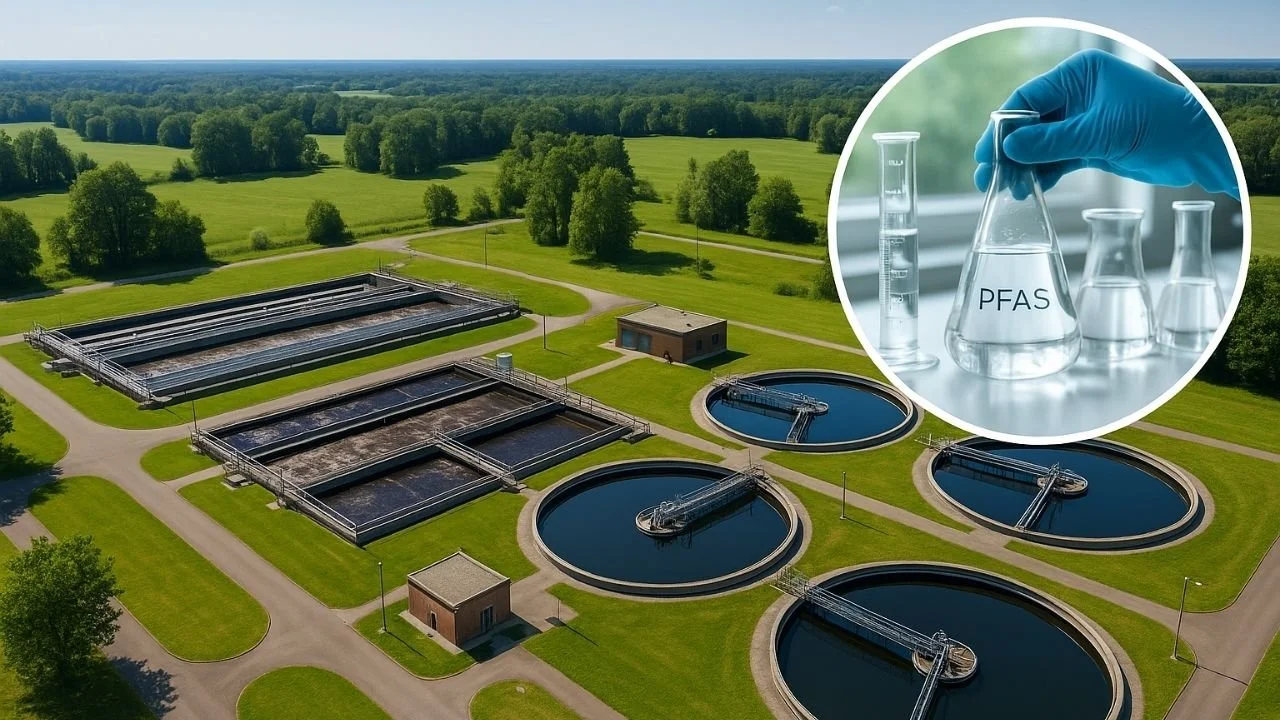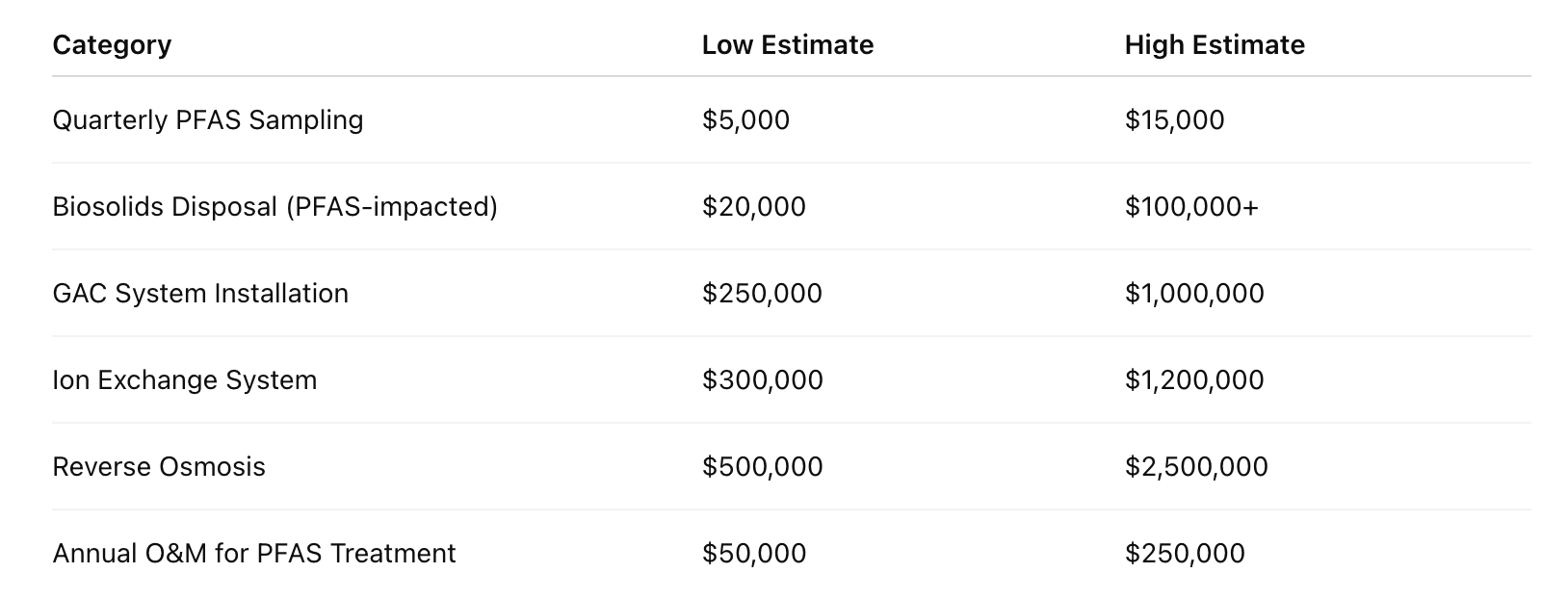What Are PFAS and Why Do They Matter in Wastewater Operations?
PFAS, or per- and polyfluoroalkyl substances, are a group of synthetic chemicals used since the 1940s for their resistance to water, oil, and heat. They are found in industrial coatings, nonstick cookware, stain-resistant fabrics, firefighting foams, and numerous other products.
PFAS are often called “forever chemicals” because they do not degrade naturally in the environment. They accumulate in soil, water, and living organisms. In wastewater systems, PFAS pass through traditional treatment processes and remain in effluent and biosolids.
These compounds have been linked to health risks such as certain cancers, immune system effects, developmental issues, and environmental persistence. For wastewater operators in NJ, PA, and NY, PFAS represent both a regulatory compliance challenge and an operational cost driver.
How Do PFAS Enter Wastewater Systems in the Tri-State Region?
In New Jersey, Pennsylvania, and New York, PFAS contamination in wastewater comes from multiple sources:
Industrial Discharges
Chemical manufacturing plants
Textile mills producing stain-resistant fabrics
Metal plating operations using PFAS-based surfactants
Firefighting Foam Runoff
Airport facilities
Fire training centers
Industrial fire suppression systems
Landfill Leachate
PFAS-containing waste in municipal and industrial landfills
Leachate sent to treatment plants without PFAS pretreatment
Domestic Wastewater
Consumer products containing PFAS washed into the sewer
Laundry from clothing treated with PFAS-based coatings
Cleaning and personal care products with PFAS
Stormwater Infiltration
Runoff from PFAS-impacted sites entering combined sewer systems
What Are the 2025 PFAS Regulations in New Jersey, Pennsylvania, and New York?
New Jersey PFAS Rules (2025)
The New Jersey Department of Environmental Protection (NJDEP) has some of the strictest PFAS regulations in the country.
Pennsylvania PFAS Rules (2025)
The Pennsylvania Department of Environmental Protection (PA DEP) is expanding PFAS oversight.
New York PFAS Rules (2025)
New York’s Department of Environmental Conservation (DEC) and Department of Health (DOH) are coordinating enforcement.
What Operational Challenges Do PFAS Regulations Create?
Testing Costs and Complexity
Certified laboratory analysis for PFAS can cost $300–$500 per sample
Special handling requirements increase labor needs
Sludge Management Restrictions
Land application bans or limits for PFAS-impacted biosolids
Higher landfill tipping fees for sludge disposal
Treatment Process Adjustments
Additional filtration or adsorption steps
Increased chemical usage in some processes
Staff Training Requirements
Specialized sampling protocols
Understanding new permit conditions
Regulatory Scrutiny
Higher frequency of inspections and reporting
What Treatment Technologies Can Remove PFAS from Wastewater?
While no single solution fits every facility, these technologies have proven effective for certain PFAS removal goals:
Granular Activated Carbon (GAC)
Widely used for PFAS adsorption
Requires periodic media changeouts
Ion Exchange Resins
High selectivity for specific PFAS compounds
Can complement GAC systems
Reverse Osmosis (RO)
Removes broad range of PFAS
Generates concentrated brine waste
High-Temperature Incineration
Used for PFAS destruction in solids
Limited availability and high cost
Emerging Technologies
Electrochemical oxidation
Plasma-based treatments
Novel sorbents
How Much Does PFAS Compliance Cost?
Costs vary by facility size, PFAS levels, and treatment needs. Approximate annual cost ranges for a mid-sized municipal facility in NJ, PA, or NY:
Case Example: PFAS Monitoring at a Mid-Sized NJ Facility
A municipal wastewater treatment plant in central New Jersey, processing 4 MGD, was required to begin quarterly PFAS sampling in January 2025. Initial results showed elevated PFOA and PFOS from industrial sources.
Actions taken:
Conducted industrial pretreatment inspections for all permitted users
Identified a metal finishing facility as the primary contributor
Required installation of on-site ion exchange pretreatment
Reduced influent PFAS levels by 60% within two quarters
Step-by-Step Checklist for PFAS Compliance in NJ, PA, and NY
Review your current NJPDES, SPDES, or NPDES permit for PFAS conditions.
Establish baseline PFAS levels in influent, effluent, and biosolids.
Identify potential PFAS sources in your service area.
Engage with industries on source control measures.
Evaluate treatment technologies for feasibility.
Train staff on PFAS sampling and handling.
Budget for testing, treatment, and disposal costs.
Maintain detailed PFAS monitoring records.
Communicate regularly with regulators.
Update your PFAS plan annually.
Why Local Expertise is Critical
Each state has unique permit structures, enforcement approaches, and disposal rules. A compliance strategy that works in Pennsylvania may fall short in New Jersey or New York. Local experience is essential to avoid costly missteps.
O&M Solutions specializes in wastewater operations and maintenance across the tri-state region. We help facilities navigate PFAS regulations, design effective compliance programs, and manage treatment solutions.
Conclusion
PFAS regulation is reshaping wastewater operations in New Jersey, Pennsylvania, and New York. Facilities that take early, decisive action will be better positioned to meet evolving permit requirements, control costs, and maintain regulatory compliance.
To schedule a PFAS readiness assessment for your facility, contact O&M Solutions today.






